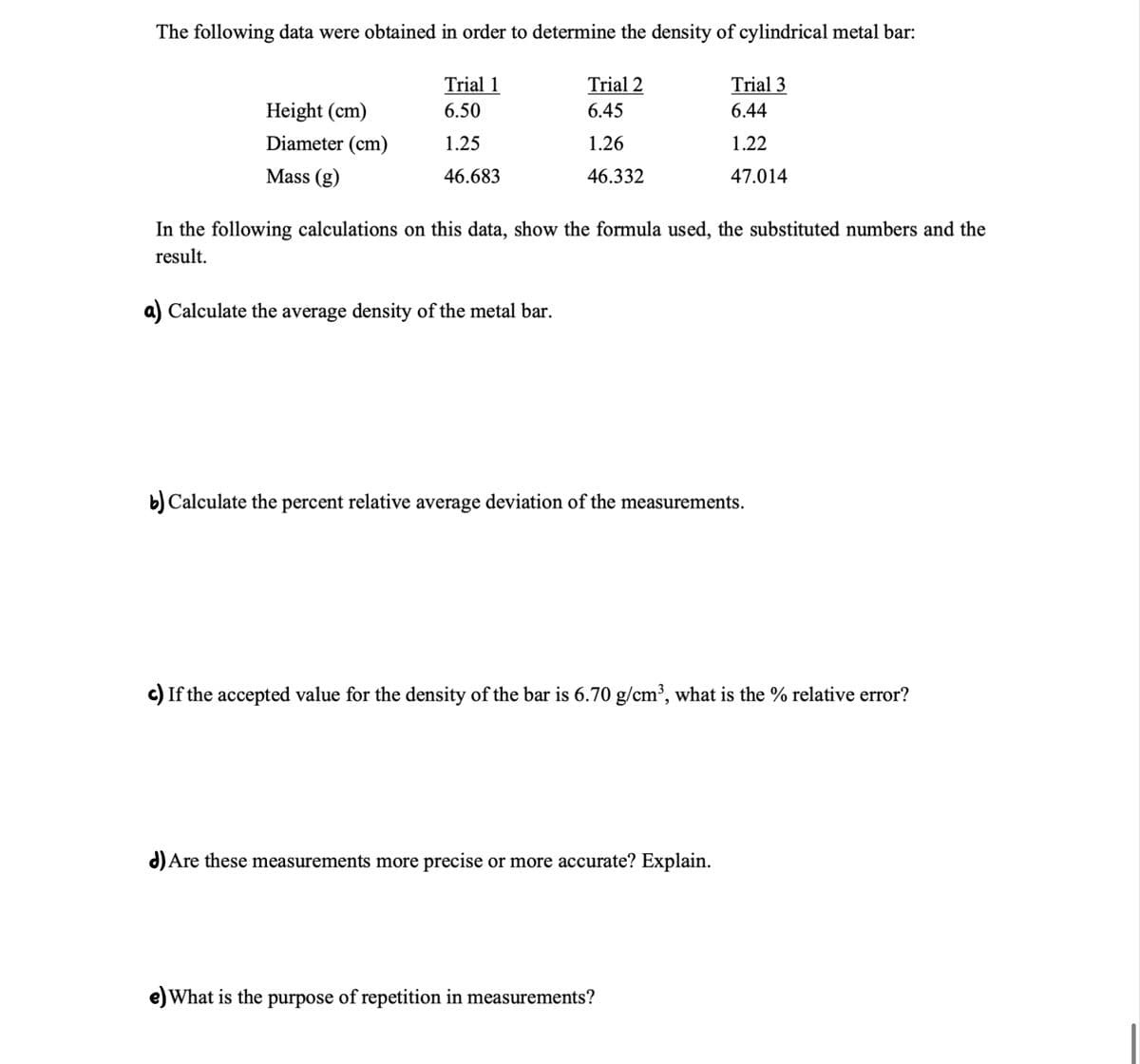The following data were obtained in order to determine the density of cylindrical metal bar: Height (cm) Diameter (cm) Mass (g) Trial 1 6.50 1.25 46.683 Trial 2 6.45 1.26 46.332 Calculate the average density of the metal bar. In the following calculations on this data, show the formula used, the substituted numbers and the result. Trial 3 6.44 1.22 47.014 b) Calculate the percent relative average deviation of the measurements. c) If the accepted value for the density of the bar is 6.70 g/cm³, what is the % relative error? d) Are these measurements more precise or more accurate? Explain. e) What is the purpose of repetition in measurements?
The following data were obtained in order to determine the density of cylindrical metal bar: Height (cm) Diameter (cm) Mass (g) Trial 1 6.50 1.25 46.683 Trial 2 6.45 1.26 46.332 Calculate the average density of the metal bar. In the following calculations on this data, show the formula used, the substituted numbers and the result. Trial 3 6.44 1.22 47.014 b) Calculate the percent relative average deviation of the measurements. c) If the accepted value for the density of the bar is 6.70 g/cm³, what is the % relative error? d) Are these measurements more precise or more accurate? Explain. e) What is the purpose of repetition in measurements?
Introduction to Chemical Engineering Thermodynamics
8th Edition
ISBN:9781259696527
Author:J.M. Smith Termodinamica en ingenieria quimica, Hendrick C Van Ness, Michael Abbott, Mark Swihart
Publisher:J.M. Smith Termodinamica en ingenieria quimica, Hendrick C Van Ness, Michael Abbott, Mark Swihart
Chapter1: Introduction
Section: Chapter Questions
Problem 1.1P
Related questions
Question
100%
answer everything for upvote

Transcribed Image Text:The following data were obtained in order to determine the density of cylindrical metal bar:
Trial 2
6.45
1.26
46.332
Height (cm)
Diameter (cm)
Mass (g)
Trial 1
6.50
1.25
46.683
In the following calculations on this data, show the formula used, the substituted numbers and the
result.
Calculate the average density of the metal bar.
Trial 3
6.44
1.22
47.014
b) Calculate the percent relative average deviation of the measurements.
c) If the accepted value for the density of the bar is 6.70 g/cm³, what is the % relative error?
d) Are these measurements more precise or more accurate? Explain.
What is the purpose of repetition in measurements?
Expert Solution
This question has been solved!
Explore an expertly crafted, step-by-step solution for a thorough understanding of key concepts.
This is a popular solution!
Trending now
This is a popular solution!
Step by step
Solved in 6 steps

Recommended textbooks for you

Introduction to Chemical Engineering Thermodynami…
Chemical Engineering
ISBN:
9781259696527
Author:
J.M. Smith Termodinamica en ingenieria quimica, Hendrick C Van Ness, Michael Abbott, Mark Swihart
Publisher:
McGraw-Hill Education

Elementary Principles of Chemical Processes, Bind…
Chemical Engineering
ISBN:
9781118431221
Author:
Richard M. Felder, Ronald W. Rousseau, Lisa G. Bullard
Publisher:
WILEY

Elements of Chemical Reaction Engineering (5th Ed…
Chemical Engineering
ISBN:
9780133887518
Author:
H. Scott Fogler
Publisher:
Prentice Hall

Introduction to Chemical Engineering Thermodynami…
Chemical Engineering
ISBN:
9781259696527
Author:
J.M. Smith Termodinamica en ingenieria quimica, Hendrick C Van Ness, Michael Abbott, Mark Swihart
Publisher:
McGraw-Hill Education

Elementary Principles of Chemical Processes, Bind…
Chemical Engineering
ISBN:
9781118431221
Author:
Richard M. Felder, Ronald W. Rousseau, Lisa G. Bullard
Publisher:
WILEY

Elements of Chemical Reaction Engineering (5th Ed…
Chemical Engineering
ISBN:
9780133887518
Author:
H. Scott Fogler
Publisher:
Prentice Hall


Industrial Plastics: Theory and Applications
Chemical Engineering
ISBN:
9781285061238
Author:
Lokensgard, Erik
Publisher:
Delmar Cengage Learning

Unit Operations of Chemical Engineering
Chemical Engineering
ISBN:
9780072848236
Author:
Warren McCabe, Julian C. Smith, Peter Harriott
Publisher:
McGraw-Hill Companies, The